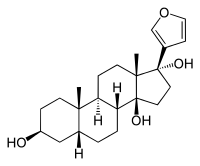Rostafuroxin
Rostafuroxin is a digitoxigenin analog that has been shown to lower blood pressure in an animal model of hypertension.[1] It modulates the effects of the enzyme Na+/K+-ATPase,[1] which maintains sodium and potassium ion gradients across plasma membranes. Rostafuroxin is being studied in clinical trials for the treatment of essential hypertension.[2][3]
 | |
| Names | |
|---|---|
| IUPAC name
(3S,5R,8R,9S,10S,13S,14S,17S)-17-(Furan-3-yl)-10,13-dimethyl-2,3,4,5,6,7,8,9,11,12,15,16-dodecahydro-1H-cyclopenta[a]phenanthrene-3,14,17-triol | |
| Identifiers | |
3D model (JSmol) |
|
PubChem CID |
|
| UNII | |
| |
| Properties | |
| C23H34O4 | |
| Molar mass | 374.521 g·mol−1 |
Except where otherwise noted, data are given for materials in their standard state (at 25 °C [77 °F], 100 kPa). | |
| Infobox references | |
References
- Ferrari, Patrizia; Ferrandi, Mara; Valentini, Giovanni; Bianchi, Giuseppe (2006). "Rostafuroxin: An ouabain antagonist that corrects renal and vascular Na+-K+- ATPase alterations in ouabain and adducin-dependent hypertension". American Journal of Physiology. Regulatory, Integrative and Comparative Physiology. 290 (3): R529–R535. doi:10.1152/ajpregu.00518.2005. PMID 16467500.
- Ferrari, Patrizia (2010). "Rostafuroxin: An ouabain-inhibitor counteracting specific forms of hypertension". Biochimica et Biophysica Acta (BBA) - Molecular Basis of Disease. 1802 (12): 1254–1258. doi:10.1016/j.BBAdis.2010.01.009. PMID 20083196.
- "Efficacy of Rostafuroxin in the Treatment of Essential Hypertension". clinicaltrials.gov.
This article is issued from Wikipedia. The text is licensed under Creative Commons - Attribution - Sharealike. Additional terms may apply for the media files.